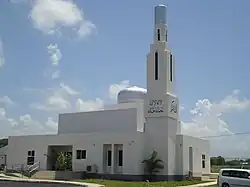Islam in Jamaica
 | |
| Total population | |
|---|---|
| 1,513[2] | |
| Religions | |
| Islam (Sunni, Shia, Ahmadiyya) | |
| Languages | |
| Main Languages spoken are English, Jamaican Patois, Jamaican Hindustani, Arabic, Urdu, Sindhi, Punjabi |
| Islam by country |
|---|
 |
|
|
Jamaica is a predominantly Christian country, with Islam being a minority religion. Due to the secular nature of Jamaica's constitution, Muslims are free to proselytize and build places of worship in the country.
The first Muslims arrived in Jamaica as enslaved people. Islam was one of the main religions of Africans brought to the Caribbean and Americas. Other Muslim groups came through the indentureship program from the Indian subcontinent, and today (in a 2011 census) make up a population of about 1,513[2]
History
The first Muslims in Jamaica were West African Moors captured in the Reconquista sold as slaves to traders, and brought to Jamaica on ships.[3] Bryan Edwards and Richard Robert Madden in their works written in the late 18th and early 19th century often wrote about the Muslim slaves of Jamaica and their situation. They wrote that many were able to memorize the Quran, declare the shahada, fasted, prayed, and some were able to write in Arabic.[4]
Over time most of them lost their Islamic identity due to forced mixing of ethnic groups. Mu’minun of African descent belonging to the Islamic nations of Mandinka, Fula, Susu, Ashanti and Hausa ceaselessly tried to maintain their Islamic practices in secrecy, while working as slaves on the plantations in Jamaica. By the time the slaves were liberated, much of the Muslim faith of the past had faded, and the freed slaves picked up the faith of their former slave masters. Some Muslim slaves returned to Africa or traveled to other parts of Latin America while others remained in Jamaica and practiced their faith in secret. These factors led to the virtual disappearance of Islam in Jamaica outside of the Indian community.[4]
About 16 percent of the 37,000 indentured Indian immigrants who arrived to Jamaica between 1845 and 1917 were Muslims. Muhammad Khan, who came to Jamaica in 1915 at the age of 15, built Masjid Ar-Rahman in Spanish Town in 1957, while Westmoreland's Masjid Hussein was built by Muhammad Golaub, who immigrated with his father at the age of 7. The indentured Muslims laid the foundation of the eight other masjids established in Jamaica since the 1960s, with the advent of an indigenous Jamaican Muslim community that now forms the majority of the Muslim populace on the island.
Current demography
The statistics for Islam in Jamaica estimate a total Muslim population of about 1,513.[2] There are several Islamic organizations and mosques in Jamaica, including the Islamic Council of Jamaica which was founded in 1981 and the Islamic Education and Dawah Center, both located in Kingston and offering classes in Islamic studies and daily prayers in congregation. Outside Kingston organizations include Masjid Al Haq in Mandeville, Masjid Al-Ihsan in Negril, Masjid-Al-Hikmah in Ocho Rios, the Port Maria Islamic Center in Saint Mary[5], Masjid al Tauheed[6] and the Mahdi Mosque in Old Harbour.[7][8]
Festivals
These are the main Islamic Festivals practiced by Jamaican Muslims:
- The Ramadan Fast
- Hosay (or Ashura)
- Id al Fitr (or Eid-Ul-Fitr)
- Eid al Adha (or Id-al-Kabir)
- Mawlid
- Miraj
- Hijrah
References
- ^ "Faith in Jamaica | Learn More About What We Believe".
- ^ a b c "Religion and the 2011 census". 4 November 2012.
- ^ Kettani, A. (1986). Muslim Minorities in the World Today. London: Mansell Publishing
- ^ a b al-Ahari, Muhammed Abdullah (1999). "The Caribbean and Latin America". In Westerlund, David; Svanberg, Ingvar (eds.). Islam Outside the Arab World. London: Routledge. pp. 445–446. ISBN 0-7007-1124-4.
- ^ "Port Maria mosque gets scores of new converts". jamaica-gleaner.com. 2017-04-01. Retrieved 2025-08-16.
- ^ "Jamaica Mosque (Ar-Rahman Mosque) – Mosqpedia". Retrieved 2025-08-16.
- ^ "Masjid Directory | Jamaica Foundation for Islamic Charity". Retrieved 2025-08-16.
- ^ Gleaner, Jamaica (2015-05-29). "Muslim places of worship in Jamaica - Caribbean Muslims". Retrieved 2025-08-16.
Further reading
- Islamic Horizons Sept/Oct 2001
- Afroz, S. (2001) 'The Jihad of 1831–1832: The Misunderstood
- Afroz, Sultana (1999). "The Manifestation of Tawhid: The Muslim Heritage of the Maroons in Jamaica". Caribbean Quarterly. 45 (1): 27–40. ISSN 0008-6495.
- Afroz, Sultana (1995). "The Unsung Slaves: Islam in Plantation Jamaica". Caribbean Quarterly. 41 (3/4): 30–44. ISSN 0008-6495.
- Afroz, Sultana (2000-10-01). "The Moghul Islamic Diaspora: The Institutionalization of Islam in Jamaica". Journal of Muslim Minority Affairs. 20 (2): 271–289. doi:10.1080/713680368. ISSN 1360-2004.
- Channer, Abdul Malik (19 April 2024). Discovering the Wonderful Islamic History of Jamaica. United States: Independently published. p. 136. ISBN 9798323420872. OCLC 1454657903.
- Afroz, Sultana (August 2012). Invisible Yet Invincible: Islamic Heritage of the Maroons and the Enslaved Africans in Jamaica. London: Austin Macauley Publishers. p. 228. ISBN 9781849631082. OCLC 830157518.
{{cite book}}: CS1 maint: year (link) - Baptist Rebellion in Jamaica' [Journal of Muslim Minority Affairs, Vol. 21, No. 2, 2001]